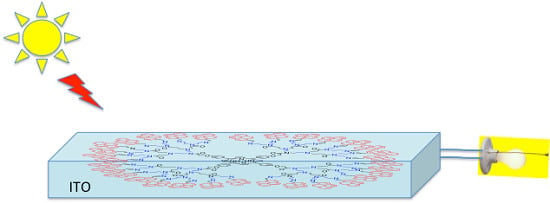Electrical Properties of Multi-Pyrene/Porphyrin-Dendrimers
Abstract
:1. Introduction
2. Results and Discussion

2.1. Optical Properties in Solution




| Sample | Pyrenemax (nm) | Bmax (nm) | Qmax (nm) | ε × 10−5 (M−1∙cm−1) |
|---|---|---|---|---|
| 3 | 243, 278, 346 | 422 | 519, 577, 591, 654 | 2.7296 |
| 4 | 244, 280, 356 | 424 | 522, 573, 590, 656 | 2.8227 |
2.2. Film Properties


2.3. Photovoltaic Properties

3. Experimental Section
3.1. General Information
3.2. Synthesis of Dendrimers 3 and 4 with Pyrene in the Periphery
4. Conclusions
Acknowledgments
Author Contributions
Conflicts of Interest
References
- Tomalia, D.A.; Fréchet, J.M.J. Dendrimers and Other Dendritic Polymers; Wiley: New York, NY, USA, 2001. [Google Scholar]
- Hecht, S.; Fréchet, J.M.J. Dendritic encapsulation of function: Applying nature’s site isolation principle from biomimetics to materials science. Angew. Chem. Int. Ed. 2001, 40, 74–91. [Google Scholar] [CrossRef]
- Duhamel, J. Internal Dynamics of dendritic molecules probed by pyrene excimer formation. Polymers 2012, 4, 211–239. [Google Scholar] [CrossRef]
- Piotti, M.E.; Rivera, F., Jr.; Bond, R.; Hawker, C.J.; Frechet, J.M.J. Synthesis and catalytic activity of unimolecular dendritic reverse micelles with “internal” functional groups. J. Am. Chem. Soc. 1999, 121, 9471–9472. [Google Scholar] [CrossRef]
- Bhyrappa, P.; Young, J.K.; Moore, J.S.; Suslick, K.S. Shape selective epoxidation of alkenes by metalloporphyrin-dendrimers. J. Mol. Catal. A Chem. 1996, 113, 109–116. [Google Scholar] [CrossRef]
- Bhyrappa, P.; Young, J.K.; Moore, J.S.; Suslick, K.S. Dendrimer-metalloporphyrins: Synthesis and catalysis. J. Am. Chem. Soc. 1996, 118, 5708–5711. [Google Scholar] [CrossRef]
- Nishiyama, N.; Stapert, H.R.; Zhang, G.D.; Takasu, D.; Jiang, D.L.; Nagano, T.; Aida, T.; Kataoka, K. Light-harvesting ionic dendrimer porphyrins as new photosensitizers for photodynamic therapy. Bioconjugate Chem. 2003, 14, 58–66. [Google Scholar] [CrossRef] [PubMed]
- Finikova, O.; Galkin, A.; Rozhkov, V.; Cordero, M.; Hägerhäll, C.; Vinogradov, S. Porphyrin and tetrabenzoporphyrin dendrimers: Tunable membrane-impermeable fluorescent pH nanosensors. J. Am. Chem. Soc. 2003, 125, 4882–4893. [Google Scholar] [CrossRef] [PubMed]
- Kiran, P.P.; Reddy, D.R.; Maiya, B.G.; Dharmadhikari, A.K.; Kumar, G.R.; Desai, N.R. Enhanced optical limiting and nonlinear absorption properties of azoarene-appended phosphorus (V) tetratolylporphyrins. Appl. Opt. 2002, 41, 7631–7636. [Google Scholar] [CrossRef] [PubMed]
- Pistolis, G.; Malliaris, A.; Paleos, C.M.; Tsiourvas, D. Study of poly(amidoamine) starburst dendrimers by fluorescence probing. Langmuir 1997, 13, 5870–5875. [Google Scholar] [CrossRef]
- Sideratou, Z.; Tsiourvas, D.; Paleos, C.M. Quaternized poly(propylene imine) dendrimers as novel pH-sensitive controlled-release systems. Langmuir 2000, 16, 1766–1769. [Google Scholar] [CrossRef]
- Wang, B.-B.; Zhang, X.; Yang, L.; Jia, X.-R.; Ji, Y.; Li, W.-S.; Wei, Y. Poly(amidoamine) dendrimers bearing electron donating chromophores: Fluorescence and electrochemical properties. Polym. Bull. 2006, 56, 63–74. [Google Scholar] [CrossRef]
- Baker, L.A.; Crooks, M.R. Photophysical properties of pyrene-functionalized poly(propylene imine) dendrimers. Macromolecules 2000, 33, 9034–9039. [Google Scholar] [CrossRef]
- Imahori, H.; Mori, Y.; Matano, Y. Nanostructured artificial photosynthesis. J. Photochem. Photobiol. C 2003, 4, 51–83. [Google Scholar] [CrossRef]
- Bing-Bing, W.; Wu-Song, L.; Xin-Ru, J.; Min, G.; Yan, J.; Xin, Z.; Zi-Chen, L.; Lei, J.; Yen, W. Self-assembly and supramolecular transition of poly(amidoamine) dendrons focally modified with aromatic chromophores. J. Colloid Interface Sci. 2007, 314, 289–296. [Google Scholar]
- Wang, B.-B.; Zhang, X.; Jia, X.-R.; Li, Z.-C.; Ji, Y.; Yang, L.; Wei, Y. Fluorescence and aggregation behavior of poly(amidoamine) dendrimers peripherally modified with aromatic chromophores: The effect of dendritic architectures. J. Am. Chem. Soc. 2004, 126, 15180–15194. [Google Scholar] [CrossRef] [PubMed]
- Yip, J.; Duhamel, J.; Bahun, G.J.; Adronov, A. A study of the dynamics of the branch ends of a series of pyrene-labeled dendrimers based on pyrene excimer formation. J. Phys. Chem. B 2010, 114, 10254–10265. [Google Scholar] [CrossRef] [PubMed]
- Figueira-Duarte, T.M.; Simon, S.C.; Wagner, M.; Druzhinin, S.I.; Zachariasse, K.A.; Mullen, K. Polypyrene dendrimers. Angew. Chem. Int. Ed. 2008, 47, 10175–10178. [Google Scholar] [CrossRef] [PubMed]
- Morales-Espinoza, E.G.; Lijanova, I.V.; Morales-Saavedra, O.G.; Torres-Zuñiga, V.; Hernandez-Ortega, S.; Martínez-García, M. Synthesis of porphyrin-dendrimers with a pyrene in the periphery and their cubic nonlinear optical properties. Molecules 2011, 16, 6950–6968. [Google Scholar] [CrossRef] [PubMed]
- Garfias-Gonzalez, K.I.; Organista-Mateos, U.; Borja-Miranda, A.; Gomez-Vidales, V.; Hernandez-Ortega, S.; Cortez-Maya, S.; Martínez-García, M. High fluorescent porphyrin-PAMAM-fluorene dendrimers. Molecules 2015, 20, 8548–8559. [Google Scholar] [CrossRef] [PubMed]
- Karki, L.; Vance, W.F.; Hupp, T.J.; LeCours, M.S.; Therien, J.M. Electronic stark effect studies of a porphyrin-based push-pull chromophore displaying a large first hyperpolarizability: State-specific contributions to β. J. Am. Chem. Soc. 1998, 120, 2606–2611. [Google Scholar] [CrossRef]
- Stewart, M.G.; Fox, A.M. Chromophore-labeled dendrons as light harvesting antennae. J. Am. Chem. Soc. 1996, 118, 4354–4360. [Google Scholar] [CrossRef]
- Gu, T.; Whitesell, K.J.; Fox, A.M. Intramolecular charge transfer in 1:1 Cu(II)/pyrenylcyclam dendrimer complexes. J. Phys. Chem. B 2006, 110, 25149–25152. [Google Scholar] [CrossRef] [PubMed]
- Fox, M.A.; Grant, J.; Melamed, V.; Torimoto, D.T.; Liu, C.Y.; Brad, A. Effect of structural variation on photocurrent efficiency in alkyl-substituted porphyrin solid-state thin layer photocells. Chem. Mater. 1998, 10, 1771–1776. [Google Scholar] [CrossRef]
- Lei, W.; Wei, L.; Jing, L.; Ying-Xi, Z.; Gang, F.; Jing-Ping, Z.; Hao, W. Supramolecular nano-aggregates based on bis(pyrene) derivatives for lysosome-targeted cell imaging. J. Phys. Chem. C 2013, 117, 26811–26820. [Google Scholar]
- Zeng, F.W.; Zimmerman, S.C. Dendrimers in supramolecular chemistry: From molecular recognition to self-assembly. Chem. Rev. 1997, 97, 1681–1712. [Google Scholar] [CrossRef] [PubMed]
- Sample Availability: Samples of the compounds are not available from the authors.
© 2015 by the authors. Licensee MDPI, Basel, Switzerland. This article is an open access article distributed under the terms and conditions of the Creative Commons Attribution license ( http://creativecommons.org/licenses/by/4.0/).
Share and Cite
Martínez-Klimov, M.E.; Organista-Mateos, U.; Borja-Miranda, A.; Rivera, M.; Amelines-Sarria, O.; Martínez-García, M. Electrical Properties of Multi-Pyrene/Porphyrin-Dendrimers. Molecules 2015, 20, 17533-17543. https://doi.org/10.3390/molecules200917533
Martínez-Klimov ME, Organista-Mateos U, Borja-Miranda A, Rivera M, Amelines-Sarria O, Martínez-García M. Electrical Properties of Multi-Pyrene/Porphyrin-Dendrimers. Molecules. 2015; 20(9):17533-17543. https://doi.org/10.3390/molecules200917533
Chicago/Turabian StyleMartínez-Klimov, Mark Euguenii, Ulises Organista-Mateos, Andrés Borja-Miranda, Margarita Rivera, Oscar Amelines-Sarria, and Marcos Martínez-García. 2015. "Electrical Properties of Multi-Pyrene/Porphyrin-Dendrimers" Molecules 20, no. 9: 17533-17543. https://doi.org/10.3390/molecules200917533






